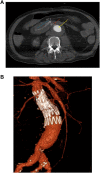Roles of endovascular aneurysm repair in management of secondary aorto-enteric fistulas
- PMID: 33391649
- PMCID: PMC7765711
- DOI: 10.1093/jscr/rjaa520
Roles of endovascular aneurysm repair in management of secondary aorto-enteric fistulas
Abstract
Secondary aorto-enteric fistulas (AEFs) are an uncommon but serious complication of abdominal aortic aneurysm (AAA) repair. Case review of two cases of secondary AEF are as follows: the first case involved a 75-year- old male who presented with AEF 1 year post-emergency open AAA repair, successfully managed with endovascular aortic aneurysm repair (EVAR) without complication. The second case involved a 75-year-old male patient 14 months post open AAA repair for an inflammatory aneurysm who presented with an iliac-enteric fistula. The previous repair was relined with a bifurcated EVAR with subsequent laparotomy and resection of the affected portion of the small bowel. Both patients on lifelong antibiotics without further episodes of sepsis, recurrence of AEF or mortality at 12 months follow up. EVAR can be successful in the management of secondary AEF. Careful patient selection, accurate image interpretation, and expedient management are key factors to successful short- and long-term outcomes.
Published by Oxford University Press and JSCR Publishing Ltd. © The Author(s) 2020.
Figures


References
-
- Kakkos SK, Papadoulas S, Tsolakis IA. Endovascular management of arterioenteric fistulas: a systemic review and meta-analysis of the literature. J Endovasc Ther 2011;18:66–77. - PubMed
-
- Bergqvist D, Björck M. Secondary arterioenteric fistulation--a systematic literature analysis. Eur J Vasc Endovasc Surg 2009;37:31–42. - PubMed
-
- Kakkos SK, Bicknell CD, Tsolakis IA, Bergqvist D, Hellenic Co-operative Group on Aortic Surgery . Editor's choice—management of secondary aorto-enteric and other abdominal arterio-enteric fistulas: a review and pooled data analysis. Eur J Vasc Endovasc Surg 2016;52:770–86. - PubMed
-
- Chakfé N, Diener H, Lejay A, Assadian O, Berard X, Caillon J, et al. Editor's choice—European Society for Vascular Surgery (ESVS) 2020 clinical practice guidelines on the Management of Vascular Graft and Endograft Infections. Eur J Vasc Endovasc Surg 2020;59:339–84. - PubMed
LinkOut - more resources
Full Text Sources

